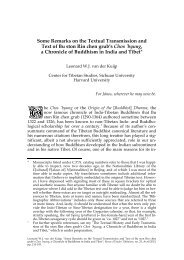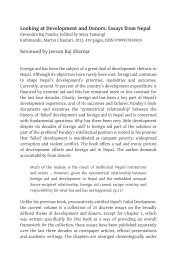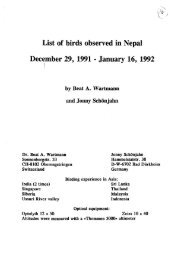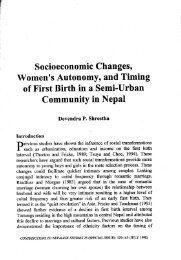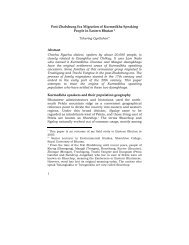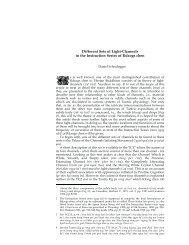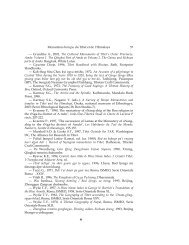Create successful ePaper yourself
Turn your PDF publications into a flip-book with our unique Google optimized e-Paper software.
Arts & Society<br />
Joseph Campbell, celebrated my<br />
thologist and storyteller, once said<br />
that, “unless the symbols and meta-<br />
32<br />
Tell Me A Story<br />
Maithili storytelling culture is still vibrant, primarily<br />
because women storytellers have kept up the tradition<br />
BY SATISH JUNG SHAHI<br />
phors of myths are kept alive by constant<br />
recreation through the arts, the life<br />
just slips away from them.” This is especially<br />
true of myths and folktales like<br />
the ones told by Maithili women,<br />
The Jackal and the Eagle (A Maithili Tale)<br />
Jackal and eagle, two friends<br />
lived near a riverbank. There<br />
was a pakhar tree near the<br />
bank, and the eagle lived in<br />
its nest on the treetop while<br />
the jackal lived near the tree’s<br />
base. Every year in Bhadau,<br />
during the Jitiya festival, all the<br />
women from the neighboring<br />
village who wanted a son,<br />
would go on a fast and bring<br />
ritual offerings of dried peas<br />
and mustard peena, which<br />
they placed on the riverbank.<br />
One year, the jackal and eagle,<br />
who had been watching the<br />
women performing the pujas<br />
every year, decided to ape the<br />
womenfolk and participate in<br />
a Jitiya ritual of their own. So<br />
the animals fasted and then<br />
tired, went to sleep. While the<br />
eagle kept his fast, the jackal<br />
got hungry and in desperation,<br />
bit off chunks from the corpse<br />
of a tehliya (oil seller) who was<br />
being cremated near the<br />
riverbank. Years later, after<br />
both the animals died they<br />
were reborn as women. The<br />
jackal became Lilawati, who<br />
got married to a rich but uneducated<br />
man, while the<br />
eagle became Silawati, who<br />
got married to a poor but educated<br />
man. Silawati and<br />
Lilawati both had many children<br />
but all of Lilawati’s children<br />
somehow died. Jealous<br />
of Silawati’s good fortune,<br />
Lilwati hired a butcher to kill<br />
Silawati’s children. Since both<br />
the women now didn’t have<br />
any children, they found themselves<br />
undertaking fasts during<br />
the next Jitiya festival. Lord<br />
Shiva, who had seen the murders,<br />
brought back to life<br />
Silawati’s children at the end<br />
of her fast. This enraged<br />
Lilawati even more, and she<br />
called a panchyat, where she<br />
accused Silawati of being a<br />
witch. She said that Silawati<br />
had used withcraft to both kill<br />
her children and to bring her<br />
own children back to life. As<br />
proof, Lilawati said that she<br />
had killed Silawati’s children.<br />
Silawati, however, won the<br />
case because the panchyat<br />
decided that her children got<br />
back their lives not through<br />
witchery but because of her<br />
devotion during the Jitiya festival.<br />
Furthermore, Lilawati’s<br />
admission of killing Silwati’s<br />
children backfired against her<br />
and was used as evidence to<br />
punish her.<br />
The Maithili society is matriarchal,<br />
and the stories told<br />
by Maithili women highlight the<br />
primacy of women, the issues<br />
of self and society as understood<br />
by them and their rich<br />
earthy knowledge of life. As<br />
exemplified by the story above:<br />
1. In most stories told by<br />
Maithili women, the protagonists<br />
are women<br />
2. The animals of Tarai, who<br />
share living space with people,<br />
play a prominent part in Maithili<br />
stories.<br />
3. The stories have a strong<br />
moral theme: don’t be greedy,<br />
don’t lie, respect your gods.<br />
4. The importance of festivals<br />
and women’s participation in<br />
them is highlighted: the<br />
panchayat says that Silawati<br />
got back her children because<br />
of her devotion during the Jitiya<br />
festival.<br />
5. Accusations of witchcraft,<br />
so prevalent in our villages, are<br />
shown for what they are:<br />
cooked-up charges.<br />
which are perpetuated through an oral<br />
culture.<br />
For ages, Maithili women’s folktales<br />
have been the repositories of Maithili culture,<br />
mores and lessons to live by. Today,<br />
Maithili storytelling is still vibrant, primarily<br />
because women storytellers have<br />
kept up the tradition. For the last six<br />
months, Coralynn Ann Davis, Assistant<br />
Professor of Women’s Studies and Anthropology<br />
at Bucknell University, Pennsylvania,<br />
has been traveling around Janakpur,<br />
documenting their tales. Davis’s work,<br />
which includes listening to, transcribing<br />
and analyzing over 140 stories told to her<br />
by a selected group of 10 women, is funded<br />
by a Fulbright Senior Research Grant.<br />
“I had done my doctoral research on<br />
women development here, a decade ago,”<br />
says Davis, “and I had to find a way to<br />
come back to Nepal as I am so much in<br />
love with it.”<br />
That love for Nepal may be a blessing.<br />
Davis, whose earlier works include,<br />
“Listen, Rama’s Wife!” “Society and the<br />
Sacred in the Saamaa-Chakeba Festival<br />
of Nepal’s Eastern Tarai,” and “Feminist<br />
Tigers and Patriarchal Lions,” will publish<br />
a book on Maithili stories based on<br />
her work. Given the pervasiveness of TV,<br />
movies and Bollywood music in the subcontinent,<br />
oral mythologies are hard<br />
pressed to keep up. And such work by<br />
people like Davis, at least help preserve<br />
the stories for future generations.<br />
The Maithili women too have done<br />
their part to ensure that their storytelling<br />
will not become just a cultural vestige.<br />
They have transformed their stories to<br />
reflect issues of power, gender and the<br />
influences of the modern world. According<br />
to Davis, that’s a good sign. Even<br />
though it’s hard to tell how these storytellers<br />
will fare in the future, Davis<br />
says,“For now, Maithili story telling<br />
practice is alive and well.”<br />
WAYNE AMTZIS<br />
MAY 30, 2004 | nation weekly






